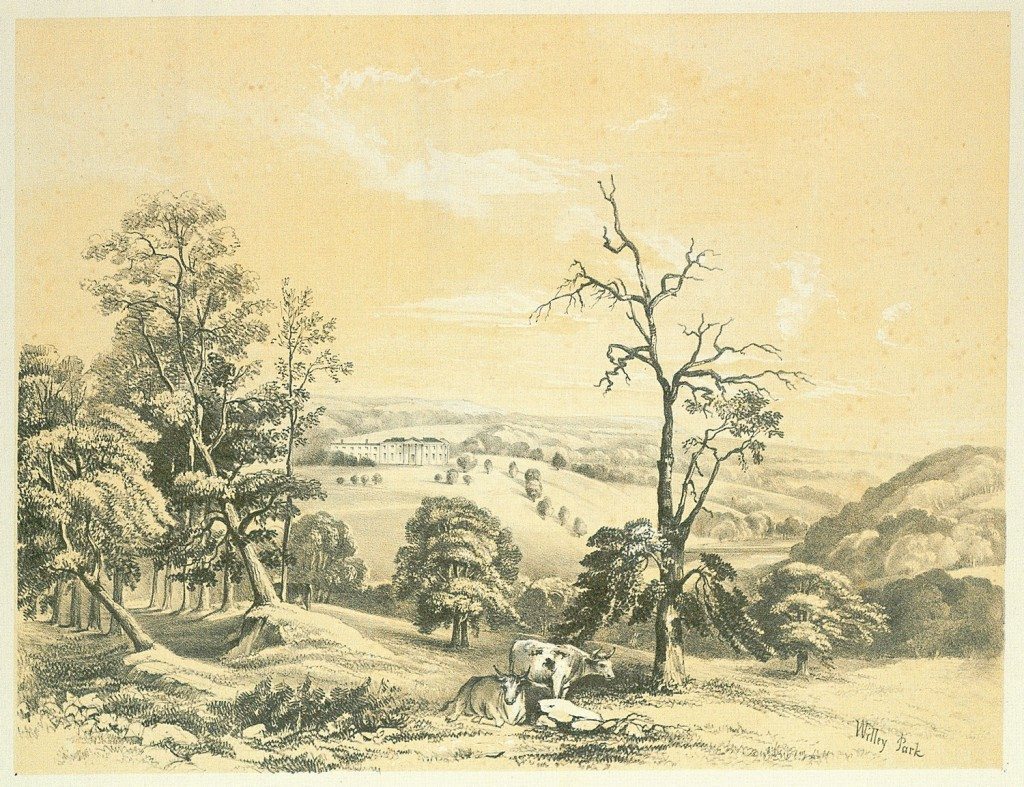Willey Park
Image from: Bayliss, Rev J C, Views in Shropshire (c. 1839). Shropshire Archives.
WILLEY PARK lies about three miles from Wenlock, four from Bridgnorth, and two from Broseley. It is pleasantly situated amidst fertile hills and vales, and itself is composed of them. From some positions the landscape possesses a most charming appearance, extending over a wide richly wooded undulating country, till the eye wearies itself in the distance.
The accompanying drawing is taken from the park near Barrow church, and embraces as much of the park and distance as could perhaps be obtained from any point without retiring too far from the building, having the hall in centre, the lakes on the right, and the sweep of the hill on which building stands. The distance lies toward Bridgnorth.
Willey hall was erected by the late LORD FORESTER: it is of the Corinthian order of architecture, and is composed of beautiful white freestone. The length of that whole front is about three hundred feet. A Corinthian portico, the height of the building, breaks the continuity of outline, and the projection of the library in the second front has the same effect. The interior is lofty, spacious, elegant, and imposing. Little remains of the old hall, except some of the offices or outbuildings. There is a very picturesque old church, at Willey, partly overgrown with ivy.
The neighbourhood of Willey possesses many objects of interest, and subjects for antiquarian research, amongst which may be named Barrow church, a small but ancient Saxon building, dedicated to St. Giles, and formerly used, it is believed, as a hospital for leprous persons, in connexion with Wenlock abbey, as St. Giles’s of Shrewsbury was with the abbey of that town. The purity of several of the Saxon arches in this little church is much admired. It is further believed to be built upon a barrow or place of sepulture, whence its name is derived: several things corroborate this belief, and prove that a great battle has been fought here in former times – the digging up of human bones in the neighbouring fields, and the discovery of an immense number beneath the church in digging for a vault.
Caughley, another adjoining village, deserves especial notice. Here the first great improvement in the body or composition of English china, was made by THOMAS TURNER, ESQ which was afterwards perfected by JOHN ROSE, ESQ of Coalport, both of whom are deceased.
The hill on the right covered with wood is Shirlet, the upper part of which is a common covered with heath, from hence there is a fine view over an immense plain and rich country extending far into Worcestershire. On the summit of Shirlet hill is a monument, a conspicuous object for many miles, erected to perpetuate the memory of a wonderful chase and a faithful dog, whose exploits with the famous TOM MOODY formed the subject of one of DIBDIN’s most popular songs. An account of this celebrated sportsman, who was a huntsman of the late GEORGE FORESTER, ESQ, of Willey, has recently been published in BENTLEY’S Miscellany. He was buried in Barrow church-yard, in 1796.






